Blow-up
By Roald Hoffmann
Images from the nanoworld challenge viewers' thinking
Images from the nanoworld challenge viewers' thinking

DOI: 10.1511/2007.63.20
I recently saw some startling images of the nanoscale world at an exhibit of scientific art in Italy. They led me to think about what we actually see, and what we make of the often magical pictures of science.
The images appear in an exhibition called "Blow-up" at the Genoa Science Festival. With a title like that, one cannot escape thinking of Michelangelo Antonioni's 1966 film of the same name. The film is an existentialist thriller in which a fashion photographer, desensitized to life, is drawn into a murder mystery. In a stunning sequence, the photographer enlarges a snapshot of two lovers in a deserted park. And enlarges the photo again. In the grainy magnification (we begin to see the silver halide crystals) he sees a man and a gun. Or does he really see them?
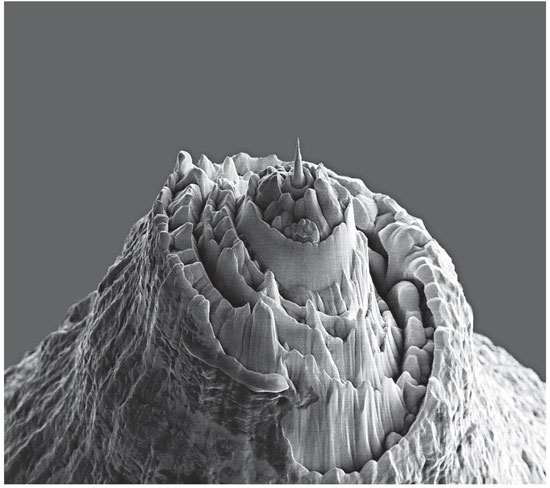
Experiment by G. C. Gazzadi and P. Gucciardi. artwork by Lucia Covi; image courtesy of S3-INFM, Modena.
The film Blow-up—to me Antonioni's best—is art. The exhibition "Blow-up" (and the accompanying book) shows remarkable images of real things seen at tremendous magnification. But … "image," "show" and "real" are fuzzy words, even for a dyed-in-the-wool (now there's an image!) realist. There's more to this story than meets the eye.
"Blow-up" shows the work of scientists associated with the National Center on Nanostructures and Biosystems at Surfaces in Modena, Italy, headed by Elisa Molinari. The images have been manipulated in a variety of ways by an excellent photographer, Lucia Covi. She in turn was inspired by the work of Felice Frankel. (Frankel writes the "Sightings" column in American Scientist.)
We are so used to looking at photographs, on film and now digital, that we think of these extremely small-scale images—the other-worldly mountain landscape of the gold tip of a near-field scanning optical microscope (a), or the diffraction pattern of a silicon crystal (b)—as snapshots, perhaps taken through some microscope. But they are not photographs.
Are they faithful images? Not really. But neither are "real" photographs, as anyone knows who has developed her own film or tinkered with an image electronically in a computer. The process of representing an underlying reality in these images is set into motion by some perturbation, usually electromagnetic in nature, of the object. A sensor transforms signals from the sample into an electronic signature (in classical photography, neat chemistry intervenes) that is manipulated and amplified, eventually becoming an array of black or colored dots on the paper before you. Light reflecting off the paper is transformed by the retina into another electrical signal that our brain processes into an image. What a journey, what a rich sequence of transformations!
Given the layers of abstraction, why do some of these images seem "real" and some "other-worldly?" A Cézanne orange, when seen in the artistic context, is as real as a photographed orange. Actually, perhaps more real than real because of its associations. This despite the fact that the Cézanne orange as an isolated visual object, stripped of its bowl and our knowledge that it is art, may appear to be a "less successful" representation of an orange.
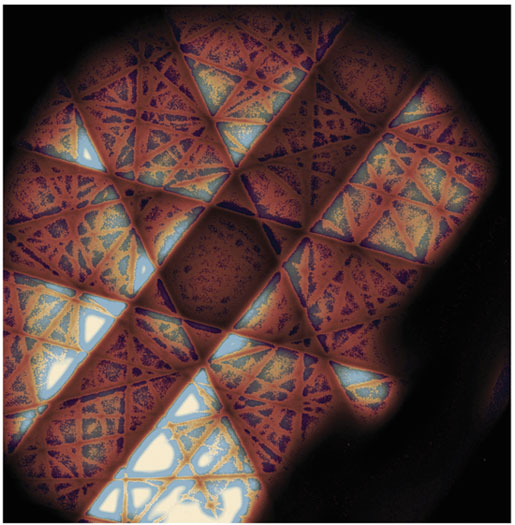
Experiment by S. Frabboni and A. Spessot; artwork by Lucia Covi; image courtesy of S3-INFM, Modena.
The humming, air-conditioned, programmer-studded rooms of Pixar or DreamWorks have shown us something else. If the intent (read "profit") is to make us believe something is real, then these wizards of modern animation can do it. Most of the high seas in the movie The Perfect Storm were computer-generated. Those terrible seas!
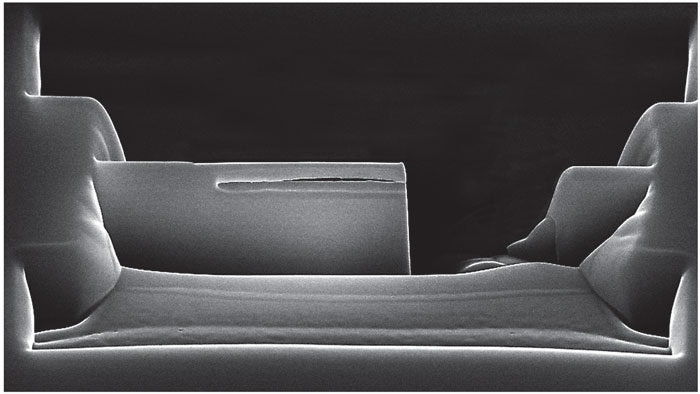
Experiment by G. C. Gazzadi and S. Frabboni; artwork by Lucia Covi; image courtesy of S3-INFM, Modena.
The pictures in the Blow-up exhibit were not intended to impress you with their quotidian naturalness. Although some images look "realistic," most do not, for instance the gold tip of a, the nanocantilever of c. Some are in-between.
Image d shows the surface of a multilayered cake of copper, silicon dioxide and silicon that contains a precise hole carved into it by a beam of ions. The rectangular orifice is shadowed so well it seems realistic, but the way the light comes off the jumbled edges in the cavity doesn't feel right. Cézanne, unencumbered by trivial fidelity to the orange before him, yet faithful to the essence of all oranges, would say you don't need better rendering. So would Antonioni.
Raw electronic images have no color, only intensity among shades of gray. Wavelength information (color) may be communicated later, but most of the images in the exhibit were not recorded that way. Yet they appear colored. Immediately, in the choice of color(s), hue and intensity, one is led to artistic decisions.
The choices offered by the software that scientists use for this task are simply garish. What's sad is that with the push of a button, the outcome of a sophisticated experiment, with ambiguities of interpretation (not a weakness) and real achievement, looks like the cover of Astounding Science Fiction from the 1930s or the Italian comic books that Umberto Eco interleaved in The Mysterious Flame of Queen Loana. Not the images before you. Lucia Covi (and Felice Frankel before her) taught the scientists that less is more and that a palette of gentle pastels and browns can be very effective.
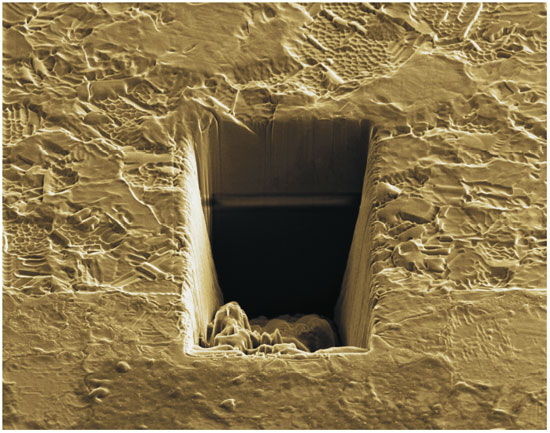
Experiment by G. C. Gazzadi and S. Frabboni; artwork by Lucia Covi; image courtesy of S3-INFM, Modena.
The visual style of an age is set by the images that have taken hold in our minds. A look at advertisements in the current New York Times or Vogue reveals out-of-focus images, cubist photomontages, surrealism and computer iconography. Blow-up,the movie, placed the anomie of the protagonist in the world of high fashion, a world in which feeling comes only through pictures.
Will the images in "Blow-up" shape future style? Some of the design elements in them point to a past: Tin oxide nanowires (e) call up the aesthetic strictures of classical Chinese painting, evoking a bamboo-like feeling coupled with the tension of Japanese calligraphy. And a Jackson Pollock drip painting. That's a lot of artistic allusion for a few nanowires.
The black-and-white images of the nanocantilever (c) and microscope tip (a) are, to me, different. These images border on the alien, with starkly illuminated softness that seems to hide something and too-sharp peaks and ridges like teeth. I find these images scary, the stuff of nightmares. Antonioni could have used them. I think there is a good chance that these, or like images, will enter the stylistic vocabulary of this century.
These pictures are separated from their scientific source in several ways. First, they depict the very small—500 nanometers, or 500 millionths of a millimeter, is the typical width. For the sake of comparison, a baby's hair might be 25,000 nanometers thick. These objects are blown up, but also homogenized in scale. Some are nanometers across, some micrometers (1 micrometer = 1,000 nanometers); the medium of presentation—exhibition or book—pushes the pictures to one rough size. The images are also printed on fine paper, neatly framed, accessible. All these maneuvers invite us to contemplate the representations as art but unintentionally distance the viewer from the real objects.
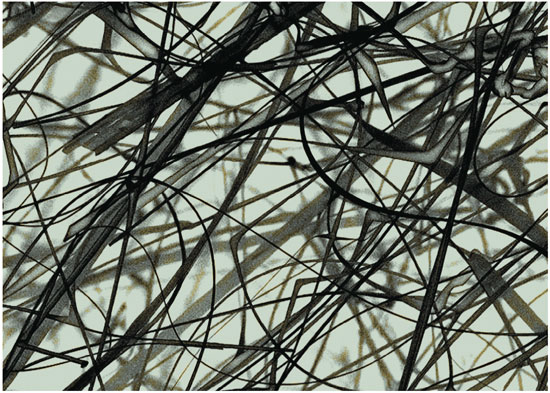
Experiment by M. Zha, D. Calestani, L. Lazzarini, G. Salviati and G. Sberveglieri; artwork by Lucia Covi; image courtesy of S3-INFM, Modena.
But we are "connoisseurs of chaos." All the associative power of linked human neural pathways is set loose when we look at pictures. In Ugo Valbusa et al.'s glass surface bombarded with argon ions (f), I see sand dunes. Which happen to be blue. No matter—the image has already sent me off to another planet, to Frank Herbert's novels, and I look for signs of Shai-Hulud in the valleys. The gold tip (a) is a digital Tower of Babel, or a wedding cake. Also a fractal set and the electron microscope image I once saw of a small worm's mouth.
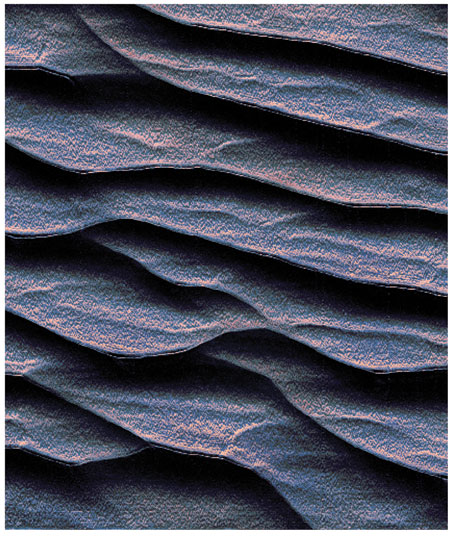
Experiment by U. Valbusa et al.; artwork by Lucia Covi; image courtesy of S3-INFM, Modena.
Is it OK to view as art, or build stories around the images of the nanoworld? I think so. An object can have multiple uses, both material and spiritual. The images we see are beautiful. That beauty is complemented by the intellectual beauty the scientist perceives in the surface, as he or she thinks hard about it. Beauty resides, as Kant said (in a fuller and more involuted way, you can be sure), in the interplay of cognition and imagination.
The nervous motion between art, narrative and science—taking in visually the formal qualities of the image, letting it please or disturb us, setting the associations loose, thinking about the underlying microscopic structure and function and how a scientist discerns and creates it—all of these make for a richer life, for understanding. For art, and just perhaps, for better science.
Thanks to Sylvie Coyaud for introducing me to Elisa Molinari's exhibition and for her ideas. This essay is adapted from my introductory essay in the catalogue to the "Blow-up" exhibition (Blow-up. 2006. Images from the Nanoworld. Bologna: Damiani Editore)
© Roald Hoffmann
Click "American Scientist" to access home page
American Scientist Comments and Discussion
To discuss our articles or comment on them, please share them and tag American Scientist on social media platforms. Here are links to our profiles on Twitter, Facebook, and LinkedIn.
If we re-share your post, we will moderate comments/discussion following our comments policy.